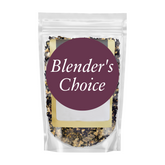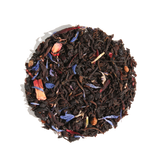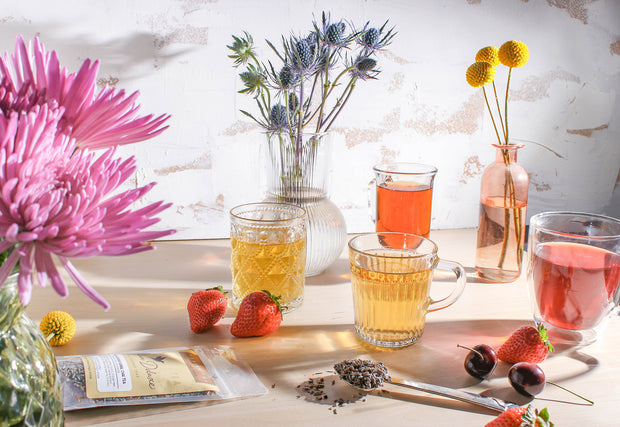
In my quest to know more about teatime in India, I naturally turned to the internet – YouTube, recipe blogs, history sites – and a lovely chef I know who is well-versed in food traditions around globe. I even went to the library – physical books are still out there! And they’re great.
Let’s start with a brief history lesson that can be summed up thusly: tea is old.
While it was difficult to nail down exactly when tea was first consumed in India, (it’s not like people were posting pictures of their morning cuppa to their Instagram in 500 BC), it is clear that the consumption of tea dates back thousands of years.
Herbal teas are an integral part of Ayurveda, an Indian medicinal practice also dating back thousands of years. To put it mildly, tea has been delicious – and good for you – for a long, long time.
Today, India is one of the largest producers and consumers of tea in the world, and that history goes back only centuries. (Practically a baby compared to the millennia of its general existence.) In the 1600s, when Britain launched its colonial expansion into the Indian continent, they spent the next several decades, spanning into centuries, trying to corner the global tea market. (China dominated at the time.) I will summarize by saying: they did.
The full story is complex and checkered. Entire books could be (and have been) written about it. Jump ahead to the 1900s, when India was the largest supplier of tea in all the land. (Literally – all the land. Anywhere. Lots and lots of tea coming out of India.) They also drank a fair bit of it themselves. That tradition lives on today, and in modern India, tea is a fundamental part of daily life.
And with tea comes... snacks!

Variety Is the Spice of Life
One basic fact which we have not yet covered: A lot of people live in India. Over a billion. That’s over 12 trillion taste buds in one country. (Yes, I googled how many taste buds are on the average human tongue.) With that abundance of taste buds comes a wealth of diversity in the world of food. One thing I quickly learned on my journey through Indian tea time snacks is that an integral part of the food culture seems to be its variety and nuances.
There are no hard and fast rules when it comes to most recipes. Flavors and ingredients are adapted region by region, chef by chef. Chef (and rock guitarist!) Cheetie Kumar deftly captures this sentiment by saying, “I always tell new cooks, in Indian food it’s always done this way except when it’s not.” Chef Madhur Jaffrey sums it up in her cookbook when she writes, “Well, that’s India for you. You can never get a simple answer.”
Simple? Maybe not. But delicious? Always!
Hearty ingredients and rich, dynamic flavors dominate the Indian tea table. Savory flavors often reign supreme with dishes rooted in ingredients like dal (lentils), chana (chickpeas), and aloo or batata (potato). Samosas, chaat, and pakora are common Indian tea time snacks when friends and family gather over steaming cups of chai (which simply means “tea”).

So Many Indian Tea Time Snacks to Love
Samosas are an iconic category of Indian food with broad and beautiful variety. United by the fact that they are a savory filled pastry and diverse in most every other way, they can be baked or fried, meat-stuffed or veggie-loaded, simply spiced or amply seasoned. I learned of chai-samosa, the pairing of samosa and tea – referred to not just in the context of an excellent snack, but more as an icon of people coming together, sharing conversation and ideas, and enjoying one another’s company just as much as they enjoy the flavorful pastries. At your next gathering, mix up the menu with crisp, aromatic samosas and a pot of creamy Full Moon Chai or complex Portland Rose City Chai. You and your guests are sure to bond over your newfound mutual love of chai-samosa.
Another popular type of food is chaat, an easy to find but difficult to define subset of toothsome snacks. Chaats vary widely, but they all seem to combine elements of crunch, spice, sweet, and sour. The word literally means “to lick,” and I saw it described repeatedly as food which possesses a “lip-smacking” or “lick the bowl” kind of quality. Which, to me, translates to: it must be delicious. For a simple, everyday snack, try a chana chaat (made with chickpeas) paired with Rainy Day Puerh or Uplifting Coconut Chai.
Pakoras are a tasty delight with ingredients coated in batter made from gram flour (besan). Besan is made from hulled and split black or brown chickpeas – making pakora naturally gluten-free!
In my wanderings, I cross-referenced many different recipes for pakora. As we have learned is true of so many Indian dishes, recipes for pakora (also called pakoda, bhaji, bhajia, and much more...) are diverse in terms of their measurements and spices added. Some use corn starch or rice flour to intensify the crispiness of the final snack, while others use only the gram flour. Cumin, salt, and coriander seemed to be staple spices in all of them, with other flavors popping in and out of the different variations. Some included mango powder (amchoor or amchur), asafetida (hing), turmeric, red chili flakes or chili powder, garam masala, and a host of other spices. They all sounded amazing. A crispy vegetable pakora served alongside a steaming mug of Spice of Life black tea is a surefire recipe for an awesome teatime.
I was fortunate enough to enjoy pakora recently, compliments of Chef Kim Mahan (the aforementioned lovely chef). She was kind enough to share her recipe with me, and now I will share it with you so that we all may benefit from the joy that is derived from Indian tea time snacks.

Chef Kim’s Onion Pakora
Serves 4 – 6
Ingredients:
- 1.5 pounds yellow onion (about 4) – peeled, halved, and thinly sliced
- 1 teaspoon salt
- 1.5 pounds yellow onions peeled, halved and thinly sliced
- 1 teaspoon salt
- 1 teaspoon ground coriander
- 1 teaspoon ground cumin
- 1/2 teaspoon ground turmeric
- 3/4 cup chickpea flour (besan)
- 1/2 teaspoon baking powder
- 1 fresh green chili seeded and chopped (or a few slices of jarred jalapeños, chopped)
- 1/4 cup cilantro chopped
- Vegetable oil for frying
- Lemon wedges for serving
Directions:
Place peeled and sliced onions in a colander. Add the salt and toss well.
Set the colander on a plate and let stand for 45 minutes to extract moisture from the onions. Rinse, then squeeze out excess moisture.
Combine dry ingredients in a medium bowl.
Place onions in a large mixing bowl with the chili and cilantro. Add dry ingredients.
Mix together with your hands until mixture starts to stick together.
Form mixture into 12 golf ball-sized pakora.
Over medium-low heat, heat vegetable oil in a large frying pan (be sure there is at least 1/2 inch to 1 inch of oil covering the bottom of the pan.) The oil should be about 350 degrees before you add the pakora. (If you have a thermometer, that’s great. If not, test the oil with a small piece of dough. If it sizzles and rises slowly to the top of the oil, your oil is ready. If it rises quickly, your oil is too hot. If the dough does not sizzle, the oil is too cold.)
Fry pakora in heated oil, being careful not to crowd the pan as you add them. Fry until golden brown, turning once. (It should generally take about 6-8 minutes total.)
Remove pakora from pan with a slotted spoon and drain on paper towels.
Continue until all pakoras are cooked.
Serve with a lemon wedge and your favorite chutney!
Note: Chef Kim’s recipe varies from many others I encountered, which call for adding water to your dry ingredients to form a batter. Though her methodology differs, I can attest to the fact that the pakora is delicious! If you would like to make your pakora with the batter method, simply add water, a few tablespoons at a time, to your flour and baking soda until it forms a thick, drop-able, lump-free batter. (You might need 1/3 to 1/2 cup of water.) Then add your remaining dry ingredients and proceed with the recipe.
Also note: The given recipe calls for onions, but you can take the basic ingredients and concepts and adapt them to your tastes. (A gift for your 9,000 taste buds!) Experiment with other vegetables – I saw recipes using cauliflower, potatoes, spinach, cabbage, peppers, green beans, you name it – or try it with your favorite meats. Get creative with the spices – a little garam masala, maybe some cayenne if you like an extra kick. Make it your own!

!['Chocoholic' Chocolate Tea Variety Pack [6-Pack Variety of Flavors]](http://www.plumdeluxe.com/cdn/shop/files/2.01-1800x1800-PlumDeluxe-DAJ-274695.jpg?v=1736886689&width=165)
![Patisserie Dessert Tea Variety Pack [6-Pack Variety of Flavors]](http://www.plumdeluxe.com/cdn/shop/files/4.01_-_1800_x_1800_-_Plum_Deluxe_-_DAJ_-_274695.jpg?v=1736886720&width=165)















